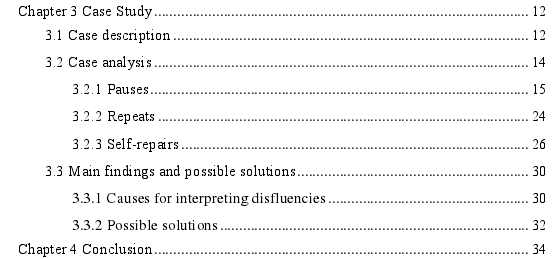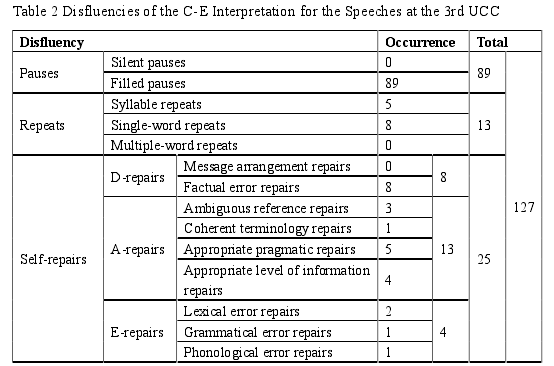国际会议论文哪里有?本研究发现,最常出现的不流利是完全停顿,其次是A-修复。D-修复和单字重复是第三常见的不流利。然后,在Levelt的言语产生和自我监控模型框架下,作者分析了导致概念化、形成、表达和监控阶段不流畅的因素,并得出结论:词汇搜索和选择效率低下,句法处理能力不足,记笔记和解码笔记的效率低下会导致口译不流利。此外,口误或压力导致的语音规划错误、个人习惯和口译员的自我监控能力有时与口译不流利的发生有关。
Chapter 1 Introduction
Disfluencies exist in everyday speeches and conversations, and interpreting activities can be seen as special cases of speech production. Therefore, disfluency phenomena can also be found in consecutive interpretation, and act as important indicators of how proficiently an interpreter performs during his or her interpreting task.
Generally speaking, disfluency phenomena are often considered to be directly related to how well a speaker commands a language in which he or she makes a speech. They are not only “important components of natural speeches”, but also “a concrete and quantifiable analysis basis for the cognitive study of some abstract concepts in linguistics, such as the language production process and meaning construction” (Zhang Weiwei et al. 2019: 119).
As China has been developing fast especially since the reform and opening up, it is experiencing huge growth in the demand for proficient interpreters because of increasing trading activities, academic seminars, inter-governmental conferences, etc. Seeing from today’s interpreter market, Chinese interpreters are now rising up to more challenges than in the last century, which include a diversity of interpreting scenarios and larger coverage of topics; moreover, increasingly extensive and high-level international exchanges held in or by China are calling for more highly-competent Chinese interpreters. According to Dai Zhaohui’s analysis on TEM 8 examinees’ records of their C-E and E-C interpreting tests, pauses and repetitions still repeatedly happen in their output, and their self-repair strategies do not seem to produce ideal results (2011). Therefore, pragmatically speaking, this research can probably help find out different types of disfluencies during the delivery of Chinese interpreters, so as to bring up targeted solutions to the disfluencies of their output and improve their interpreting quality.

Chapter 2 Literature Review
2.1 Speech fluency
The concept of speech fluency has been applied to interpreting research since interpreting activities are regarded as a process of discourse delivery. According to Sylvi Rennert’s research, fluency has been studied as one of the many aspects to judge interpreting quality since the 1980s (2010: 101), and it has long been a part of the important criteria for the assessment of an interpreter’s performance (Pöchhacker 2016: 133). Pöchhacker concludes that fluency refers to the delivery of the speech, or the “physical characteristics of the acoustic signals produced by the speaker that go beyond the verbal component of speech”, and suggests that speech rate and pauses are central parameters of fluency (2015: 165). He holds that much research on fluency actually examines deviations from specific norms, such as paralinguistic phenomena like “drawled phonemes, voiced hesitation and anomalous pauses in terms of position or length” and linguistic phenomena like “false starts, repairs and slips” (2015: 165-166).
Paul Lennon points out that an interpreter should provide the audience with a finished product instead of imposing an analytical process of the information in the interpretation on the listeners, which adds to their loads of comprehending the speeches (1990: 391-392). He brings forward the broad sense and narrow sense of fluency: The former one represents oral proficiency of a foreign language, and the latter one refers to one of the components to grade oral proficiency among “correctness, idiomaticness, relevance, appropriateness, pronunciation, lexical range”, etc. (1990: 389). He believes that research on speech fluencies often emphasises speech production “at the tempo of native speakers”, with few “silent pauses, hesitations, fill pauses, self-corrections, repetitions, false starts” (1990: 390).
Chapter 3 Case Study
3.1 Case description
Since speeches at most of the seminars and discussions of the 3rd UCC were interpreted simultaneously, the author chooses the press conference at the closing ceremony with consecutive interpretation as her research material.
The research material is a video clip recorded at the press conference which lasts for about 1 hour. The press conference commenced with Ernesto Zedillo’s English speech, who is the former President of Mexico, and then Shaukat Aziz, former Prime Minister of Pakistan addressed the audience in English. After Mr. Zedillo and Mr. Aziz made their speeches, both Mr. Zhu Min, Vice Chairman of CIIDS, and Mr. Li Junru, Executive Vice Chairman of CIIDS made remarks in Chinese, which were rendered into English, and only the corresponding interpretations of their speeches are the research objects.
This material is chosen and analysed for three reasons. First, the speeches were given on a formal occasion, so the interpretation of the event is of relatively high reliability. Besides, two Chinese speakers made speeches without notes, which means that the interpreter had to analyse their speeches, transform them from Chinese (L1) to English (L2), monitor his output and make timely adjustments when needed. During this process, some disfluencies may occur due to a lack of smoothness when he was processing the message. Second, the content of this material is mainly about the speakers’ impressions of the Understanding China Conference, which involve China’s economic growth, scientific and technological innovation, intellectual property protection, people-to-people exchanges and commercial cooperation with other countries and regions, etc. All of the above topics are repeatedly brought up during China’s integration into the trend of globalisation as well as in foreigners’ efforts to understand China better. Therefore, this material is believed to be of practical significance in this new era, and it also closely overlaps the MTI training orientation of the author’s university. Third, the speeches and the interpretation have a proper speech rate, duration and information density.
3.2 Case analysis
In this part, the author collects the disfluencies of the interpretation which was presented at the 3rd UCC Press Conference. The data is shown as follows.

It is worth mentioning that among all 127 disfluencies, filled pauses turn out to occur much more frequently than other disfluencies, accounting for almost 70% of them. Then factual error repairs and single-word repeats come second.
Chapter 4 Conclusion
This research is based on the analysis of the interpretation at the Press Briefing of the 3rd Understanding China Conference in terms of the disfluency phenomena during consecutive interpreting. It classifies the disfluencies in the case into three general categories, which are pauses (including silent and filled pauses), repeats (including syllable, single-word, multiple-word repeats) and self-repairs (including D-, A- and E-repairs) and analyses the disfluencies statistically. It is found that filled pauses turn out to be the most frequently occurring disfluencies and A-repairs come second. D-repairs and single-word repeats are the third most frequent disfluencies. Then, under the framework of Levelt’s speech production and self-monitoring model, the author analyses the factors that lead to the disfluencies in the conceptualising, formulating, articulating and monitoring stages, and concludes that inefficient lexical search and selection, inadequate syntactic processing capability, and unproficiency in note-taking and note-decoding can give rise to interpreting disfluencies. Besides, a slip of the tongue or pressure-driven phonetic planning errors, personal habits, and the interpreter’s self-monitoring competence are sometimes connected with the occurrence of interpreting disfluencies.
Based on the analysis, some suggestions are given to trainee interpreters whose L1 is Chinese and L2 is English. For the conceptualising process, familiarity with background knowledge and task-bound knowledge can be developed through adequate preparation work so that the Chinese messages can be transformed into English ones as soon as possible. For the formulating process, the knowledge store with lexis can be expanded and quicker information matching can be invoked. Besides, syntactic structures can also be kept in interpreters’ knowledge store. Controlling speech rate and relieve nervousness can reduce the occurrence of a slip of tongue which always leads to repairs and repeats, and daily practices can help a lot with examining unnecessary inarticulation. Self-repairs derived from the self-monitoring process can be slashed by properly organising the structure of the notes and developing a clear and explicit set of shorthand notation.
reference(omitted)

